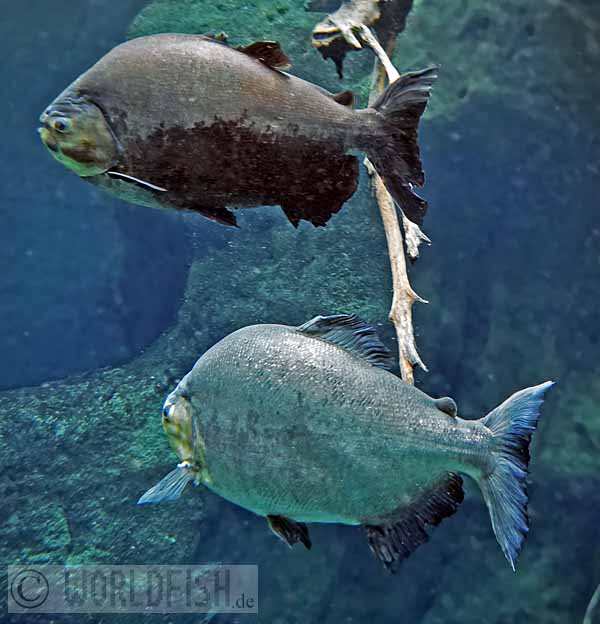Colossoma macropomum
(Cuvier, 1816)
|
Familie: Serrasalmidae SynonymeMyletes macropomus Cuvier, 1816
Salmo tambaqui Kner, 1860
Myletes nigripinnis Cope, 1878
Melloina tambaqui Amaral Campos, 1946
Lokale Bezeichnungen |
 Colossoma macropomum -- (C) Erwin Schraml |
Typen
Holotypus: MNHN A-8626 (dry) .
Siehe: Eschmeyer, W.N., Fricke, R. & Van der Laan, R. (eds.) 2024. Catalog of Fishes electronic version
Typusfundort: Brasilien.
Etymologie
Makro- (= groß); poma (= operculum=, bezieht sich auf den großen, breiten Kiemendeckel. (Übersetzt aus: The ETYFish Project)
Verbreitung
Amazonas- und Orinoco-Becken (Bolivien, Brasilien, Ecuador, Kolumbien, Peru, Venezuela); eingeführt oder gezüchtet in Kuba, der Dominikanischen Republik, Honduras, Costa Rica, Jamaika, Panama, Italien und Südostasien.
IUCN Status

EX Extinct (ausgestorben)
EW Extinct in the Wild (in der Natur ausgestorben)
CR Critically Endangered (vom Aussterben bedroht)EN Endangered (stark gefährdet)
VU Vulnerable (gefährdet)
NT Near Threatened (potenziell gefährdet)
LC Least Concern (nicht gefährdet)
RE Regionally Extinct (regional oder national ausgestorben)DD Data Deficient (ungenügende Datengrundlage)
NE Not Evaluated (nicht beurteilt)
Status: Stand 17.10.2022: NE Not Evaluated (nicht beurteilt)
Gefahren für diese Art: (nicht beurteilt)
Literatur
- Cuvier G. 1816–1817. Le Règne Animal distribué d'après son organisation pour servir de base à l'histoire naturelle des animaux et d'introduction à l'anatomie comparée. Avec Figures, dessinées d'après nature. Tome I. Contenant l'introduction, les mammifères et les oiseaux. Edition 1, Deterville, Paris. pp. i-xxxvii + 1–540. (doi) BHL Zitatseite [:185, Pl. 10 (fig. 1), !!, als Myletes macropomus]
- Cuvier, G. 1818. Sur les poissons du sous-genre Mylètes. Mémoires du Muséum National d'Histoire Naturelle, Paris, 4: 444-456, Pls. 21-22. Zitatseite [:453, Pl. 21 (fig. 3), Beschreibung, Zeichnung, als Myletes macropomus]
- Kner, R. 1860. Zur Familie der Characinen. III Folge. Der Ichthyologischen Beiträge. Denkschriften der Östereichischen Akademie der Wissenschaften, 18: 9–62, pls. 1–8. Zitatseite [:21 [13], als Salmo tambaqui erwähnt: nomen nudum]
- Cope, E.D. 1872. On the fishes of the Ambyiacu River. Proceedings of the Academy of Natural Sciences of Philadelphia, 23: 250-294, Pls. 3-16. (BHL) Zitatseite [:268, Pl. 12 (fig. 2), !!, als Myletes oculus]
- Cope, E.D. 1878. Synopsis of the fishes of the Peruvian Amazon, obtained by Professor Orton during his expeditions of 1873 and 1877. Proceedings of the American Philosophical Society, 17 (101): 673-701. (BHL) Zitatseite [:693, !!, als Myletes nigripinnis]
- Steindachner, F. 1881. Beiträge zur Kenntniss der Flussfische Südamerika's. II. Denkschriften der Kaiserlichen Akademie der Wissenschaften in Wien, Mathematisch-Naturwissenschaftliche Classe, 43: 103–146, Pls. 1–7. Zitatseite [:125f, Beschreibung, Zeichnung, als Myletes nigripinnis]
- Amaral Campos, A. 1946. Novo gênero e novas espécies de Caracídios do baixo amazonas. Papéis Avulsos do Departamento de Zoologia, Secretaria da Agricultura, São Paulo, 7 (17): 217-220, 1 pl. Zitatseite [:220, Fig. 3, !!, als Melloina tambaqui]
- Géry, J. 1977. Characoids of the World. T.F.H. Publications, Neptune City. 1-672. Zitatseite [:255, Beschreibung, als Colossoma macropomum; :255,258, Farbfoto, als Colossoma oculus]
- Lüling, K.H. 1980. Das Fischparadies Yarina Cocha. Exkursion zum mittleren Ucayali in Ostperu. Aquarien Magazin, 14 (5): 248-254. Zitatseite [:254*, Zeichnung, Vorkommen, als Piaractus nigripinnis]
- Goulding, M. & Carvalho, M.L. 1982. Life history and management of the tambaqui (Colossoma macropomum, Characidae): an important Amazonian food fish. Revista Brasileira de Zoologia, 1 (2): 107-133. Zitatseite [:, als Colossoma macropomum]
- Machado-Allison, A. 1982. Estudios sobre la subfamilia Serrasalminae (Teleostei, Characidae). Parte 1. Estudio comparado de los juveniles de las " cachamas " de venezuela (generos Colossoma y Piaractus). Acta Biologica Venezuelica, 11 (3): 1-101. Zitatseite [:43]
- Ortega, H. & Vari, R.P. 1986. Annotated checklist of the freshwater fishes of Peru. Smithsonian Contributions to Zoology, 437: iii + 25 p. Zitatseite [:8, gelistet]
- Kochetov, A.M. 1989. Ėkzotičeskie ryby [Экзотические рыбы / Exotic fishes], Lesnaja promyšlennost', Moscow. 239 p. [auf russisch] Zitatseite [:101, als Colossoma orbignyanum: nomen nudum]
- Saint-Paul, U. 1989. Aquaculture in Latin America. Indigenous species promise increased yields. Naga, 12 (1): 3-5. Zitatseite [:3-5|Vorkommen, Fortpflanzung]
- Riehl, R. & Baensch, H.A. 1990. Aquarien Atlas Band 1. 8. Auflage. Mergus Verlag, Melle. Zitatseite [:350|Farbfoto, Synonyme]
- Almeida-Val, V.M.F., Schwantes, M.L.B. & Val, A.L. 1990. LDH isozymes in Amazon fish 1. Electrophoretic studies on two species from Serrasalmidae family: Mylossoma duriventris and Colossoma macropopum. Comparative Biochemistry and Physiology Part B: Comparative Biochemistry, 95 (1): 77-84. (doi) Zitatseite [:77-84|Physiologie, /Enzymes ]
- Taphorn, D.C. 1992. The characiform fishes of the Apure River drainage, Venezuela. BioLlania Edición Especial, n.4. Monografias Cientificas del Museo de Ciencias Naturales. UNELLEZ Guanare, estado Portuguesa, Venezuela, 537 pp. Zitatseite [:161; Myletes nigripinnis u. Myletes oculus als Synonyme]
- Loubens, G. & Panfili, J. 1997. Biologie de Colossoma macropomum (Teleostei: Serrasalmidae) dans le bassin du Mamoré (Amazonie bolivienne). Ichthyological Exploration of Freshwaters, 8 (1): 1-22. Zitatseite [:1-22|Farbfoto, Fortpflanzung, Vorkommen]
- Glaser, U. 2000. Aqualog Photo Collection, No. 3. Verlag A.C.S. Zitatseite [:58, Farbfoto, als Colossoma oculus]
- Aquaristik Aktuell[2002/06:7|gelistet, Exportverbot]
- Reis, R.E., Kullander, S.O. & Ferraris, Jr., C.J. 2003. Check List of the Freshwater Fishes of South and Central America. CLOFFSCA. EDIPUCRS, Porto Alegre. 729pp. Zitatseite [:183, Autor: Jégu; Melloina tambaqui als Synonym]
- Henderson, P. & Jinkings, K. 2003. The flooded forest. Today's Fishkeeper, (2): 32-35. Zitatseite [:33*|Farbfoto, Vorkommen]
- Ott, G. 2007. VDA-FBS Referenz Nr. 2006-010. Colossoma macropomum. VDA-aktuell (Verbands-Zeitschrift des "Verbandes Deutscher Vereine für Aquarien und Terrarienkunde e.V."), 13 (2): 15. Zitatseite [:15|Farbfoto, Beschreibung]
- Goulding, M. 2009. Die Zukunft der amazonischen Fischfauna. Amazonas, #25, 5 (5): 26-35. Zitatseite [:29*|Farbfoto, Überleben]
- Kiefner, G. 2019. Aquarianer unterwegs. Silu-cha Bolivia 2018. News Bookazine, #7: 10-36. Zitatseite [: 16*, Farbfoto, Biotop]
- Zarske, A. 2020. Piranhas, Pirayas oder Sägesalmler, noch heute rätselhaft. Aquaristik Fachmagazin, #273, 52 (3): 6-31. Zitatseite [: 14*, Farbfoto, Übersichtsartikel]
- Zarske, A. 2022. Die Salmler. Characiformes. Versuch einer aktuellen Übersicht. Aquaristik Fachmagazin, #286, 54 (August/September): 6-30. Zitatseite [:17*, Farbfoto, Übersichtsartikel]